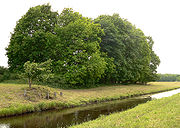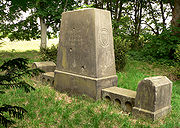
Hodenhagen Castle
Encyclopedia

Lowland castle
The term lowland castle or plains castle describes a type of castle based that is situated on a lowland, plain or valley floor, as opposed to one built on higher ground such as a hill spur...
(Niederungsburg) built in the 13th century in the vicinity of Hodenhagen
Hodenhagen
Hodenhagen is a municipality in the district of Heidekreis, in Lower Saxony, Germany. The town was once the site of Hudemühlen Castle, which is now completely destroyed. The castle was famous as the home of the kobold Hinzelmann. The site of another medieval castle, Hodenhagen Castle on the River...
in the German state of Lower Saxony
Lower Saxony
Lower Saxony is a German state situated in north-western Germany and is second in area and fourth in population among the sixteen states of Germany...
. This medieval manor house only lasted just under 100 years and was destroyed in 1289.
Location
The castle was situated in an uninhabited region by the important river crossing of the old post road over the River Meiße. Today the site of the castle is just a few metres from the entrance to the Serengeti ParkSerengeti Park
The Serengeti Park in Hodenhagen, Lower Saxony, is a zoo and leisure park in North Germany.-History:In 1972 the Duke of Bedford had the idea of building the largest safari park in Europe with partners from America. In 1974 this plan was realised and, since then, the Sepe family has run the park...
, half in a small copse and half in farmland.
Description

Hodenberg
Hodenberg is the name of an old Lower Saxon noble family. - History :Since early times the von Hodenberg lords were protectors of the monastery at Bücken founded by Archbishop Rembert von Bremen. Their name was probably derived from this hereditary office, because in Low German the word Hode...
in the middle of the 19th century. At that time the last remnants of the castle - the earth ramparts, moats and stone ruins - were levelled or removed. According to the sketch the castle had an oval rampart, 109 x 95 m in diameter, which bordered immediately on the Meiße. The rampart was originally surrounded by a moat that was filled by water from the river. At the time the sketch was drawn, a farm track already cut through the ramparts to the interior. Within the ramparts was the foundation of a round keep with a 10 m diameter and an outside wall, 2.5 m thick. The bases of other walls were identified at other locations inside the ramparts.
Near the castle site Wilhelm von Hodenberg believed he had located a farmyard with a smithy
Smithy
Smithy may refer to:* Forge, also called a smithy, the workplace of a smith or a blacksmith* Smith , sometimes referred to as a smithy, a person involved in the shaping of metal objects...
, because he had found pieces of iron and slag
Slag
Slag is a partially vitreous by-product of smelting ore to separate the metal fraction from the unwanted fraction. It can usually be considered to be a mixture of metal oxides and silicon dioxide. However, slags can contain metal sulfides and metal atoms in the elemental form...
. In addition the records show there was a castle mill on the Meiße as well as a historical castle chapel, the sites of which have not been identified.
In 1856 the von Hodenberg family commemorated the castle by erecting a monument which is located on the old castle site in the small copse.
History

Hodenberg
Hodenberg is the name of an old Lower Saxon noble family. - History :Since early times the von Hodenberg lords were protectors of the monastery at Bücken founded by Archbishop Rembert von Bremen. Their name was probably derived from this hereditary office, because in Low German the word Hode...
s, who were an important aristocratic family in the region. After they had been forced by the counts of Hoya to move their seat from Altenbücken in about 1200, they built Hodenhagen Castle on the Meiße
Meiße
The Meiße is a German river in the state of Lower Saxony, near the Lüneburg Heath, and a right-hand tributary of the River Aller.- Origin and course :The Meiße emerges south of Wietzendorf in the nature reserve of Großes Moor bei Becklingen...
about 30 kilometres (18.6 mi) further west. It is thought to have been built around 1200, but the castle is first mentioned in 1244.
Based at Hodenhagen Castle, the land of the aristocratic von Hodenberg family lay geographically and relationally between that of the counts of Hoya and the House of Welf who were pushing westwards. The Welf Duke, Otto the Strict
Otto II, Duke of Brunswick-Lüneburg
Otto II, Duke of Brunswick and Lüneburg , also known as Otto the Strict , came from the House of Welf and was Prince of Lüneburg from 1277 to 1330.-Life:...
, had Hodenhagen Castle destroyed in 1289 by slighting
Slighting
A slighting is the deliberate destruction, partial or complete, of a fortification without opposition. During the English Civil War this was to render it unusable as a fort.-Middle Ages:...
. In a deed
Deed
A deed is any legal instrument in writing which passes, or affirms or confirms something which passes, an interest, right, or property and that is signed, attested, delivered, and in some jurisdictions sealed...
dated 27 August 1289 he had had it assigned to him from Heinrich von Hodenberg. In this manner the Hodenberg family became subjected to the Duke and lost their regional authority; instead they became vassal
Vassal
A vassal or feudatory is a person who has entered into a mutual obligation to a lord or monarch in the context of the feudal system in medieval Europe. The obligations often included military support and mutual protection, in exchange for certain privileges, usually including the grant of land held...
s of the Welfs. It is thought that the destruction of the castle also served to contain the widespread activities of the robber baron
Robber baron
A robber baron or robber knight was an unscrupulous and despotic nobility of the medieval period in Europe, for example, Berlichingen. It has slightly different meanings in different countries. In modern US parlance, the term is also used to describe unscrupulous industrialists...
s, that permeated the lower strata of the nobility at that time.
After the destruction of Hodenhagen Castle the family line moved its seat further west to the present-day Hodenhagen hamlet of Hudemühlen. There they built a manor house with defensive features, that formed the basis for the village of Hodenhagen established in 1400. Not until 1448 was the court of the von Hodenbergs described in the records as a castle (Schloss). The building was converted in the 16th century into the splendid, renaissance castle of Hudemühlen, that was demolished in the 19th century.
Similar fortifications in the local area
Within the neighbourhood, in the valley of the AllerAller
The Aller is a river, long, in the states of Saxony-Anhalt and Lower Saxony in Germany. It is a right-hand, and hence eastern, tributary of the River Weser and is also its largest tributary. Its last form the Lower Aller federal waterway...
, there is a number of other medieval castles, some of similar design. These fortifications include those in Bierde
Bierde
Bierde is a village in the municipality of Böhme, Lower Saxony, that is part of Heidekreis district in the German state of Lower Saxony.- Bierder Burg :...
, Ahlden (Bunkenburg
Bunkenburg
Bunkenburg was a castle built during the 13th and 14th centuries in the shape of a circular fort located on the banks of the River Aller opposite Ahlden in north Germany. Only a section of the rampart, roughly 60 metres long and 3 metres high, exists today...
), Essel
Essel
Essel is a municipality in the Heidekreis district, in Lower Saxony, Germany. Most of the village is located on the southern bank of the river Aller. The A 7 motorway runs through the village.-Subdivisions:The municipality of Essel comprises 4 subdivisions:...
(Uhlenburg
Uhlenburg
Uhlenburg is the site of a lowland castle that was built in the 14th century close to the River Aller near Essel in the German state of Lower Saxony...
) (Blankenburg Castle
Blankenburg Castle
Blankenburg Castle was a small castle in the village of Engehausen in the municipality of Essel in the German state of Lower Saxony. It dates roughly to the 13th century. All that remains are parts of the surrounding rampart...
), Rethem and Grethem
Grethem
Grethem is a municipality in the district of Heidekreis, in Lower Saxony, Germany....
(Blankenhagen Castle
Blankenhagen Castle
Blankenhagen Castle was a lowland castle , whose ruins are located by the River Aller near Grethem in Lower Saxony, Germany. The motte-and-bailey castle is believed to have been built around 1200...
).
Hodenhagen Castle belongs to the group of former castles, that were researched between 2003-2005 by the Burgenlandschaft Aller-Leine-Tal (B.A.L.T.) project. The project was supported by the European aid programme LEADER+, because it had located castle sites in the Aller-Leine Valley
Aller-Leine Valley
The Aller-Leine Valley is the name of a region north of Hanover in Germany, that has been created for the purpose of regional marketing and inter-community cooperation...
area. However Hodenhagen Castle was only studied by aerial photography
Aerial archaeology
Aerial archaeology is the study of archaeological remains by examining them from altitude.The advantages of gaining a good aerial view of the ground had been long appreciated by archaeologists as a high viewpoint permits a better appreciation of fine details and their relationships within the wider...
; no excavations have been carried out to date.
Literature
- Burgen im Fluss, Herausgeber: Landkreis Soltau-Fallingbostel, Bad Fallingbostel, 2005, ISBN 3-00-017281-5

